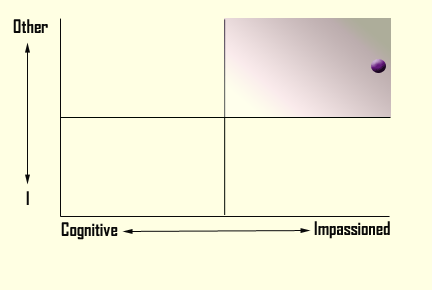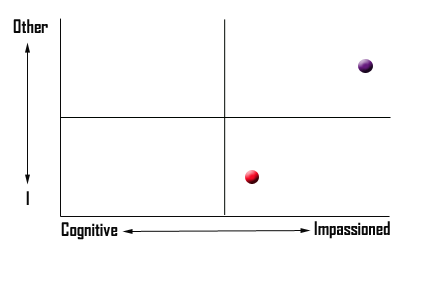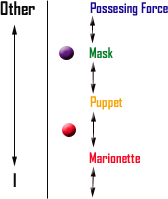So in thinking about my last post in the series, it occurs to me that there are a lot of things that enable intimacy in roleplay. This post is about three of them.
Art
Ages ago, on Yud’s Dice, Brand talked about how the word art was a power word…
“Art is a loaded term. Art is a word used to give value to one human endeavor or activity above another. Art is a way of saying ‘This thing is important to my stance on the human social condition and gives/takes power away from the part of society I inhabit.’ ” ~Brand, in Games, Art, Power, and Me
…and I’m entirely on board with that. I think discussions about what is and is not “artâ€, (just like those about what is and is not a “gameâ€) are most often semantic wars used to legitimize one endeavor while marginalizing another. However, in thinking about the more extreme kinds of RPG situations where intimacy is strongly enabled, it occurs to me that “art†is a power word loaded in other, possibly more positive ways.
Just as I can legitimize or marginalize an activity that other people are doing by bestowing or withholding the word “artâ€. I can use the same word to bestow an activity I am participating in with a particular kind of freedom, not just to empower it from an objective cultural perspective, but to empower it socially within the activity itself. “Artâ€, we are taught to believe, is something of value that transcends the normative rules of human behavior. “Art†is something that is breaks us out of our mundane, human experience and compels us instead to move towards a sublime contemplation of the human condition; it’s a goal greater than value of its elements or of its participants.
So what does that mean to intimacy? Well, when an organizer of an RPG-as-art event uses the word art, most importantly, without even opening up an actual discussion, it begins a framework for a social contract between the participants. It says: this event is about seeking a sublime reflection of the human condition, and the product of it is greater than my desire or your desire, and aims to make a creation greater than the sum of our inputs. It mandates a particularly demanding level of investment on behalf of the participants, but at the same time promises a particularly powerful artistic license and bestows a lack of judgment in the process of, and a particular sense legitimacy on the participants as “artistsâ€.
Similarly, several of these events, especially in the range of the Nordic Art-LARPS, span play over extreme periods of time (such as Europa, a five day, fully in-character LARP set in and simulated like a refugee camp in Eastern Europe) which demands a particularly intense level of intimacy not just with other participants, but with the story, the setting and the character. This is linked in with what I said above about the particularly demanding level of investment mandated to participants. I also don’t see it as a co-incidence that these mechanisms of intimacy are coupled with a pro-immersion mandate. After all, I started this discussion to explain how intimacy was a vital component of support for those playing in character-socketed Impassioned Other territory.
Now, I should be clear that I’m not at all interested right now in the discussion of whether the product of these RPG-as-art events actually are or are not art, nor whether the participants are or are not artists. What I am interested in is the way that the use of the word creates a specific cultural context drawn in a tight circle around these events that optimally should result in a powerfully intimate milieu to play in. I’m also not interested in the discussion of if RPG-as-art events are or are not better or worse than other kinds of roleplay. What I’m interested in is the way that the intimate milieu and cultural context drawn around these events facilitate the participants arriving at and achieving a common payoff.
Kink
Taking intimacy to the emotional and physical extreme, BDSM roleplay is replete with mechanisms to facilitate intimate play. Although this may not be the first thing that jumps to mind for you when considering roleplay, BDSM play certainly involves taking on characters, degrees of immersive activity, and story play to varying degrees of completion, spontaneous and organized, small and large from the episodic to the epic. Although it’s rarely discussed, there is a good deal of people involved in both activities independently, and I’ve also talked to a wide variety of folks who have described the BDSM activity that has spilled over from their LARP or tabletop experiences.
Participants in BDSM play put a strong emphasis on safe words and scene negotiation. Whether the event is between consenting partners or as part of a larger, organized venue, a vast, varied, and clearly defined vocabulary aids in the the identification of hard and soft limits for the participants (kind of like lines and veils in power sexual situations) and events are not only flagged to facilitate the understanding of the event’s social contract, but occasionally they come accompanied with fully explicit, written codes of conduct or actual legal contracts that must be signed before walking in the door. Also, not unlike NGH and IWNAY set up boundaries and support space, some BSDM scenes use SSC (Safe, Sane and Consensual) and RACK (Risk Aware Consensual Kink) philosophies to guide or inform their play practices and use ritual elements to transition into and out of the play space.
The tools in a BDSM context are, for the most part, better defined and the contracts more explicit because the potential for harm is considerably greater than it is with conventional roleplay, and so there is an absolute need for them to be more efficient and reliable. Here, like in RPG-as-art events, a particular investment and level of intimacy is demanded and created in a direct response towards supporting the achievement of a particular payoff. And like my conclusions above, I find it no surprise at all that BDSM events also have pro-immersion mandates. Even in situations where there are no distinct characters to play, becoming the *role* you play in the BDSM context is, well, the point, and for many involved, the pathway to sexual fulfillment; it’s the payoff.
The Virtual
Finally, and distinct from the previous enablers, virtual spaces such as MU**’s , MMORPGS, PBP and PbeM, by their very nature as anonymous gateways enable participants to achieve a heightened sense of intimacy. Here I am not talking about games like Bitches in the Vineyard, in which a MUSH was used to facilitate the play of a bunch of people who knew each other from another context (Story Games) but for whom physical distance made around the table play impossible (Brand and I are in Toronto, Jess Pease in Boston, Jess Hammer in New Jersey, Nancy in California). Instead, I’m talking about standard PBP, MUSH or MMORG play, where a participants logs into an interface to play a game and meets the (majority of) other participants through the game.
While you could argue that actually intimacy is impossible in such an anonymous environment, when you look at the reasons that intimacy are important to the Impassioned Other context, as an environment which supports personal vulnerability and unfettered social interaction, you can see what I’m getting at. When a participant in this situation engages with the game, who they are in actuality ceases to matter, and assumption of the Other is facilitated. An enhanced sense of safety is inherent both because of the anonymity of the medium, and also because the ritual is built in: to enter the game space, I logged in, to get back to the safe space, I log out.
Environmental factors may also enhance this, for all of these games are most played from the safest of spaces: your own home, they are often played while alone, without outside interruption, frequently in dim light looking at a bright monitor in a way that lends itself to a mildly hypnotic connection. Participants can fully be vulnerable to the game environment because their selves are fully protected, they can full give over to the character or the story they are “living”and because whatever information they give over can be carefully constructed, can express things that are of a more vulnerable, personal context. They have less fear of being judged, and can escape more effectively in a fantasy context.
Again, just like in RPG-as-art events and BDSM play, most of these virtual play spaces (all of them, I warrant, in which characters exist as more than an icon on the screen) are pro-immersion environments that encourage participants to act fully within the context of the character in reaction to the game world. I don’t find it surprising that intimacy and a permission to be vulnerable is found in the same context.
Whether its that Impassioned Others are drawn to intimate spaces or that intimate spaces are constructed to support Impassioned Other play, I’m not sure, but I thought this would be a good start to looking at the connection between the two to see how the qualities of the social interaction encourage particular modes of play. Also, if you abstract, you might glean how different qualities of social interaction might discourage particular modes of play. How, for example, would a person playing in a Cognitive I mode with a system socket fit into an Art LARP, a hardcore BDSM scene, or a strict IC MUSH?


